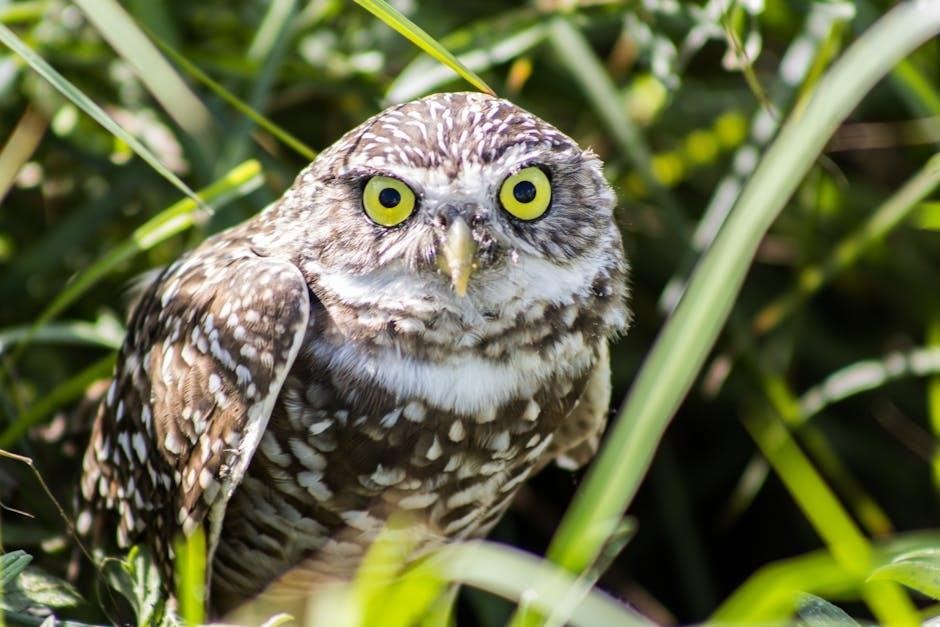Renowned ornithologist Jack Griggs is celebrated for his expertise in bird behavior and conservation․ His comprehensive bird guide is a popular resource, offering detailed insights into various species, aiding enthusiasts and promoting conservation efforts․
1․1 Who Is Jack Griggs?
Jack Griggs is a respected ornithologist and author, known for his extensive work in bird conservation and education․ He has contributed significantly to field guides, including “All the Birds of North America” and collaborative works like “The Feeder Watcher’s Guide to Bird Feeding” and “The Bluebird Monitor’s Guide․” His expertise in bird behavior and habitat has made him a trusted name among bird enthusiasts and researchers, fostering a deeper understanding and appreciation of avian life․
1․2 Overview of the Bird Guide
Jack Griggs’ bird guide is a comprehensive resource for bird enthusiasts, featuring detailed descriptions, superb illustrations, and insights into species behavior and habitats․ It covers a wide range of birds, with a particular focus on North American species, and is designed to be both educational and user-friendly․ The guide emphasizes conservation and includes practical tips for observing and protecting birds, making it an invaluable tool for both beginners and experienced birders․

Key Features of the Bird Guide
Detailed content, stunning visuals, and a user-friendly design make Jack Griggs’ guide an essential tool for birders, combining education with practical observation tips effectively․
2․1 Detailed Illustrations and Descriptions
Jack Griggs’ bird guide excels with its vibrant, high-quality illustrations and precise descriptions, making it easier for users to identify and learn about various bird species․ Each entry includes lifecycle stages, plumage variations, and distinctive field marks, ensuring accuracy․ The detailed text complements the visuals, providing insights into behaviors, habitats, and vocalizations, making the guide indispensable for both casual birders and serious ornithologists․ This combination of art and science creates a comprehensive resource for bird enthusiasts․
2․2 Organization andEase of Use
2․2 Organization and Ease of Use
Jack Griggs’ bird guide is meticulously organized, ensuring ease of use for enthusiasts of all skill levels․ The guide features a logical structure, with species grouped by families and habitats, and includes a comprehensive index for quick access․ Color-coded tabs and clear headings enhance navigation, while concise descriptions and visual keys allow for rapid identification․ This user-friendly design makes the guide an invaluable tool for both beginners and experienced birders, fostering a seamless and enjoyable bird-watching experience․

How to Use the Bird Guide for Bird Watching
Start with the index to quickly locate species․ Use visual guides for identification, noting field marks, behavior, and habitat․ Refer to range maps for distribution insights, enhancing your bird-watching experience with precision and ease․
3․1 Identifying Bird Species
Jack Griggs’ guide excels in helping users identify bird species through detailed descriptions and visuals․ It highlights field marks, plumage variations, and beak shapes for accurate recognition․ The guide includes range maps to pinpoint habitats, aiding in narrowing down species․ Seasonal changes in appearance are also covered, ensuring comprehensive identification․ This systematic approach makes it easier for both novices and experts to correctly identify birds in the field, enhancing the overall bird-watching experience with precision and clarity․
3․2 Understanding Habitat and Behavior
Griggs’ guide emphasizes the importance of understanding bird habitats and behaviors for effective identification․ It provides insights into nesting patterns, feeding habits, and migration cycles․ By knowing where species thrive, enthusiasts can better locate them․ For example, the Eastern Bluebird prefers open areas with low vegetation․ Such details help birders predict behaviors, enhancing observation experiences․ This knowledge also aids in creating bird-friendly environments, aligning with conservation goals and enriching the connection between humans and wildlife through informed appreciation of avian life․

The Importance of Field Guides in Bird Conservation
Field guides like Jack Griggs’ are vital for conservation, offering insights into bird species, habitats, and behaviors, thereby enhancing awareness and fostering citizen science efforts to protect avian populations․
4․1 Role in Education and Awareness
Field guides like Jack Griggs’ play a crucial role in educating bird enthusiasts and the general public․ By providing detailed descriptions and illustrations, these guides help users identify species, understand habitats, and recognize behaviors․ This knowledge fosters awareness about bird conservation, encouraging individuals to engage in eco-friendly practices and support preservation efforts․ Griggs’ work, particularly his focus on species like the Eastern Bluebird, has inspired many to participate in bird monitoring and citizen science initiatives, amplifying their impact on avian protection․
4․2 Contribution to Citizen Science
Jack Griggs’ bird guide significantly contributes to citizen science by enabling enthusiasts to collect and report data on bird populations․ His detailed field guide helps participants in initiatives like Feeder Watcher’s Guide to accurately identify species and monitor changes in bird communities․ This data is crucial for researchers, aiding in the development of conservation strategies and understanding ecological trends․ Griggs’ work bridges the gap between amateur birders and professional scientists, fostering collaboration and advancing avian research on a broader scale․
Specific Bird Species Covered in the Guide
The guide focuses on the Eastern Bluebird and other small cavity-nesting birds, providing detailed insights into their habitats, behaviors, and unique characteristics, both common and rare species․
5․1 Focus on the Eastern Bluebird
The guide highlights the Eastern Bluebird, a cavity-nesting species, with detailed descriptions of its vibrant plumage, vocalizations, and nesting behaviors․ Griggs emphasizes its habitat preferences, such as open woodlands and farmlands, and provides tips for attracting these birds․ The guide also explores conservation efforts and the importance of nesting boxes․ Additionally, comparisons with other bluebird species, like the Western Bluebird, offer a broader understanding of these beloved birds and their ecological roles․
5․2 Other Small Cavity-Nesting Birds
Besides the Eastern Bluebird, the guide covers other small cavity-nesting birds, such as the Western Bluebird, Tree Swallow, and House Wren․ It details their unique behaviors, nesting patterns, and habitat preferences․ Griggs provides tips for distinguishing species and offers insights into their ecological roles․ The guide also addresses conservation challenges and solutions, emphasizing the importance of nesting boxes and habitat preservation to support these birds․ This section is invaluable for enthusiasts seeking a deeper understanding of cavity-nesting species․
Jack Griggs’ Collaborative Works
Jack Griggs has collaborated on notable works, including The Feeder Watcher’s Guide to Bird Feeding and The Bluebird Monitor’s Guide, focusing on bird behavior and conservation practices․
6․1 The Feeder Watcher’s Guide to Bird Feeding
Co-authored with Margaret Barker, The Feeder Watcher’s Guide to Bird Feeding offers practical advice on creating bird-friendly environments․ Published in 2000, it details optimal feeder placement, seed selection, and maintenance tips․ The guide emphasizes attracting diverse species and understanding their feeding behaviors․ Its accessible format makes it a valuable resource for both casual birders and dedicated enthusiasts, fostering a deeper connection with nature and promoting bird conservation through informed feeding practices․
6․2 The Bluebird Monitor’s Guide
Co-authored by Jack Griggs, Cynthia Berger, and Keith Kridler, The Bluebird Monitor’s Guide focuses on cavity-nesting birds, particularly bluebirds․ Published in 2001, it provides detailed monitoring techniques, nest box management, and strategies to protect these species․ The guide is essential for conservationists and enthusiasts, offering insights into habitat preservation and species behavior․ Its practical approach makes it a vital tool for anyone involved in bluebird conservation efforts, ensuring the survival of these iconic birds;

Reviews and Recommendations
Jack Griggs’ bird guide has received high praise from experts and bird enthusiasts alike․ Its clarity and depth make it a must-have resource for birders of all levels․
7․1 Expert Testimonials
Renowned ornithologists and conservationists praise Jack Griggs’ bird guide for its accuracy and accessibility․ Cynthia Berger and Keith Kridler highlight its value for both beginners and advanced birders․ Kenn Kaufman notes its comprehensive approach to species identification․ Experts appreciate the guide’s detailed illustrations and practical insights, making it an indispensable tool for bird enthusiasts․ Its clear organization and user-friendly design ensure it remains a top choice for fieldwork and research․
7․2 Feedback from Bird Enthusiasts
Bird enthusiasts widely acclaim Jack Griggs’ bird guide for its clarity and portability․ Many praise its detailed descriptions and vibrant illustrations, which make identifying species effortless․ Beginners appreciate its user-friendly layout, while experienced birders value its depth of information․ The guide is often described as a “must-have” for field trips, enhancing the overall birding experience․ Its engaging insights and practical tips have made it a favorite among nature lovers, fostering a deeper connection with bird conservation and observation․

Jack Griggs’ bird guide has left a lasting impact on bird enthusiasts, bridging education and inspiration․ His work continues to foster a deeper connection with nature, encouraging exploration and appreciation of the natural world through bird watching․
8․1 The Legacy of Jack Griggs’ Work
Jack Griggs’ contributions to ornithology and conservation are profound․ His bird guide has educated countless enthusiasts, fostering awareness and appreciation for avian diversity․ By blending scientific accuracy with accessibility, his work has empowered both experts and amateurs, leaving a lasting legacy in the field of bird conservation and education․
8․2 Encouragement to Explore Bird Watching
Bird watching offers a rewarding connection with nature, fostering curiosity and appreciation for wildlife․ Jack Griggs’ guide inspires enthusiasts to explore diverse species, emphasizing conservation and education․ Whether you’re a seasoned birder or a beginner, his work motivates you to grab binoculars, venture outdoors, and discover the beauty of birds․ Let his guide be your gateway to a lifelong passion for avian exploration and stewardship․
